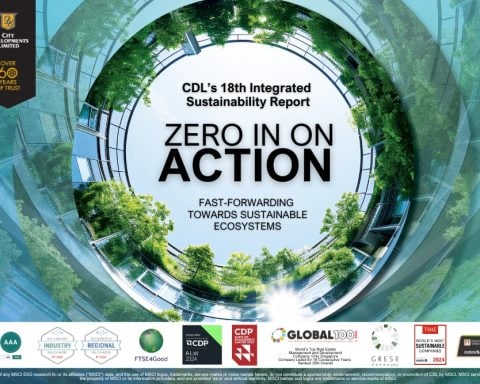Mining is essential to create most of what we use in society today, from roads and bridges to computers and medical equipment. The industry will become even more important as we transition to a low-carbon economy, given that metals and minerals — such as copper, aluminum, lithium and rare earths — are crucial ingredients in everything from electric vehicles to wind turbines and solar panels.
We’ll also need more of them: Consider that a typical electric vehicle requires six times more minerals than those with a conventional internal combustion engine, while an offshore wind farm requires 13 times the amount of mined minerals versus the equivalent amount of power generation from the natural gas-fired power station.
It's paradoxical, given that mining is an extractive industry that is responsible for about 4 to 7 percent of the world’s global gas emissions. Since there is no substitute for these essential commodities, the mining industry will need to decarbonize to become a welcome part of the low-carbon future, says David Willick, vice-president and regional leader of mining, metals and minerals in North America for Schneider Electric.
Willick argues the time to act is now given growing awareness of the negative impacts of climate change and the opportunities for change.
“The carbon-free movement is being driven by a convergence of investor interest, public and customer concern over global warming, regulatory actions and technological innovation,” says Willick, whose team helps mining operations extract metals and minerals in the most sustainable way.
The mining industry understands the pressure: More than 27 per cent of mining and metals organizations identified the need to improve brand equity as a top driver for sustainability, compared to 18 per cent for the industry, according to a report from market intelligence company International Data Corporation (IDC), commissioned by Schneider Electric.
It underscores why so many miners are in the midst of a huge transformation — moving away from its traditional extraction methods toward a technology-driven future that’s more sustainable and supports the global transition to a low-carbon economy.
Climate-smart mining, minerals and metals practices are good for business
Given the market is demanding sustainability be a priority, a more sustainable operating model is helping mining companies build their businesses. Specifically, many can attract new business partners who are interested in being more sustainable across their supply chains.
Willick points to Anglo-Australian multinational miner Rio Tinto as a key example. The company has an agreement to provide coffee company Nespresso with responsibly sourced aluminum for its capsules. Rio Tinto and Alcoa — two of the world’s largest aluminum suppliers — also have an agreement through the joint-venture Elysis, to produce carbon-free aluminum for Apple to use in its products by 2024.
The ability to successfully drive sustainability through every part of the business will be critical for mining companies to thrive in the low-carbon economy.
Willick notes several forward-thinking companies have already taken a leadership role and established aggressive benchmarks for sustainability.
For instance, Rio Tinto has set ambitious emissions targets to reduce its carbon intensity by a further 30 per cent and its absolute emissions by a further 15 per cent by 2030, alongside establishing a $1 billion fund to invest in climate-related projects. These targets will bring the company closer to achieving its long-term goal of becoming net zero emissions by 2050 (which includes emissions from shipping its products).
Anglo American, meanwhile, has set a target of achieving carbon neutrality across its operations (Scopes 1 and 2) before 2040, while Canada’s Teck Resources Ltd. is aiming to be carbon neutral across all of its operations by 2050, disposing of zero industrial waste by 2040, and transitioning to the use of seawater or low-quality water for all operations in water-scarce regions by 2040.
The 28-member International Council on Mining and Metals (ICMM) also recently committed to a goal of net zero scope 1 and 2 greenhouse gas (GHG) emissions by 2050 or sooner, in line with the ambitions of the Paris Agreement.
Sustainability targets are no longer voluntary for companies that want to participate in the new, green economy, Willick adds.
"It's essential to have a roadmap to decarbonization to move forward," he says, which includes investing in technology to make it happen.
“For leading mining companies, these investments as part of the push towards sustainability isn’t just a reaction to market forces; it’s strategic.”
- David Willick, VP and regional leader of mining, metals and minerals for Schneider Electric
Technology to drive safety, lower costs and improve sustainability
Setting targets is important, but it takes investment in new emission-reduction technologies and systems to help companies get there.
The broad goal is sustainability, but these investments can also save companies money through lower energy costs and reduce risk by increasing safety across their operations. The result is greater value creation.
“If you lower your cost per ton by utilizing some of these technologies and sustainability methods, then you become more efficient,” Willick says.
Some of the technologies that miners are using include artificial intelligence and machine-learning for predictive maintenance, to the use of data and analytics to make process improvements.
More efficient companies are also better-positioned to weather the commodity cycles that are well known in the industry — and outperform their peers. “As commodity prices fluctuate, those that can produce the commodities with the lowest cost per tonne are always going to be in a good situation,” Willick notes.
The pandemic, particularly the urgency to adopt remote technology, has accelerated many companies' plans to invest in innovation that drives sustainability. For example, Willick says Schneider Electric has seen a dramatic increase in customer engagement since the pandemic started around March 2020, many of which are looking to boost their investments in innovation and technology.
“Schneider Electric is really good at helping customers decarbonize through their entire supply chain, and we are taking that on,” he says, adding his company also has set aggressive targets to be carbon neutral by 2025 and net zero by 2030.
“Decarbonization and digitalization plans go hand-in-hand. Being more efficient requires more digitally connected devices and requires more insights into the data.”
For instance, he says companies are using sensors during the extraction phase to glean more information about each shovel bucket or scoop, which increases yield while reducing waste rock that would have been processed, which helps to conserve the use of water and reduce tailings waste.
Big data can also be used for real-time monitoring of people and machines on the mine site, to help improve productivity as well as increase safety and protect the environment.
“The more connected a company is, the more efficient and ready for the digital future,” Willick says.
The future of resource extraction and processing is smart, digital, and sustainable
Innovation is key to building a greener, more resilient future. Adopting sustainability as a business imperative pays positive environmental, social, and governance (ESG) impacts and provides long-term economic gain and competitive advantage.
The urgency for the mining industry to address its sustainability challenge has never been greater, Willick argues, given the growing backlash from its perceived stagnant positioning on ESG performance.
He says mining companies need to implement smart, digital tools that enable them to make informed decisions and empower people across the value chain to make strategic, sustainable choices. “For leading mining companies, these investments as part of the push towards sustainability isn’t just a reaction to market forces; it’s strategic,” Willick says. “It’s the early adopters that will benefit significantly over the long term.”





